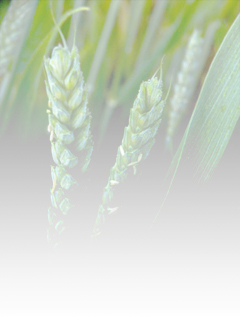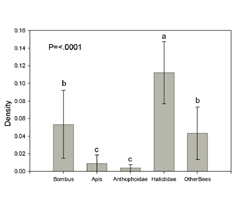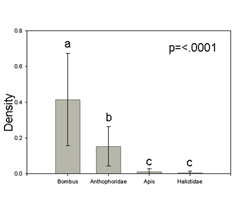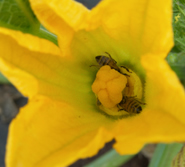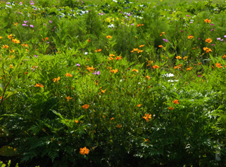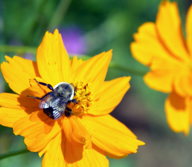Assessment and Encouragement of Native Bees
in Cucurbit Plantings
(Wilson, Skinner, Jones, Wszelaki, Smith and Windham) |
||||
|
The objectives of this study are to: 1) assess the presence and abundance of Native Bees at cucurbit plantings by flower observations; 2) encourage native bees with flower plantings and reduced tillage management through use of drip irrigation and plastic; and 3) determine optimal flower mix for flower plantings by trialing of 3 mix types. Preliminary data indicates that non-managed native bees play a significant role in pollination of certain crops on the organic farm when compared to managed honey bees. Future research will include additional sampling locations in TN to determine the regional importance of native bees in the pollination of local crops. We will also examine
Mean bee visitor density on summer squash flowers over 10 days (6/19/08 – 7/10/09) at the UT Organic Farm. 'Bombus' represent bumble bees. 'Apis' represents honey bees. The Family Anthophoridae represents the squash bees. ' Halictidae' represents the sweat bees.
Mean bee visitor density on watermelon flowers across 6 observations (during 7/1/08 – 7/18/09) at the UT Organic Farm. 'Bombus' represent bumble bees. 'Apis' represents honey bees. The Family Anthophoridae represents the squash bees. ' Halictidae' represents the sweat bees.
Mean bee visitor density on 4 Cucurbita spp. varieties at the UT Organic Farm over 3 days (during 8/12/08 – 8/15/08). 'Bombus' represent bumble bees. 'Apis' represents honey bees. The Family Anthophoridae represents the squash bees. ' Halictidae' represents the sweat bees. Learn more about squash bees at: http://bees.tennessee.edu/peponapis.htm.
|
|||


